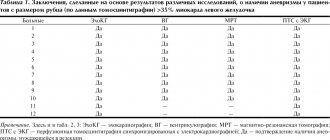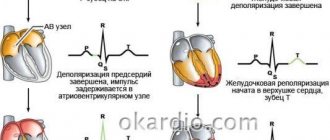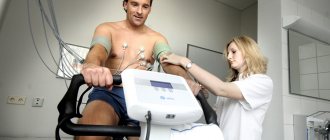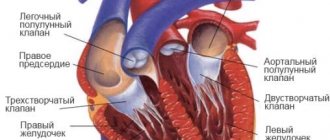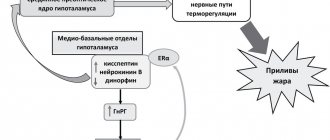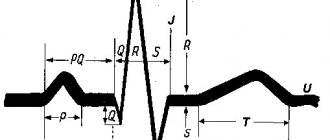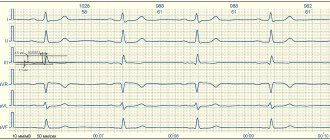Myocardial dystrophy is a complex pathological process in cells (cardiomyocytes), leading to depletion of energy reserves. At the same time, the ability to recover is not lost for a long time.
Changes occur at the level of cell metabolism. Failure of the energy synthesis process disrupts myocardial contractility. It is extremely difficult to identify clear manifestations at the initial stage. Myocardial dystrophy has been most studied in diseases accompanied by changes in metabolism (thyrotoxicosis, hypothyroidism, severe anemia, poison intoxication, vitamin deficiency).
Heart defects and myocarditis cause a combination of inflammation and degenerative changes in the myocardium. It is quite difficult to find out which of these processes prevails - inflammatory or dystrophic.
What happens in the myocardium?
Energy in myocardial cells is produced mainly during diastole. Biochemical processes occur in the presence of oxygen. Also necessary “ingredients” are vitamins, hormones, a complex of enzymes, glucose, lactic and pyruvic acids, fatty acids, ketone bodies, amino acids. Everything is delivered with blood.
The effect on the synthesis of nerve impulses has been proven. They regulate reactions and can intensify or slow them down. The heart has an important ability: it can synthesize energy from glucose with the participation of oxygen, but it is also capable of “holding out” for some time and extracting kilocalories from reserve glycogen without oxygen (anaerobic pathway).
Myocardial dystrophy manifests itself when all reserves are exhausted and the heart becomes energy deficient. If the process drags on for a long time and the body does not receive additional substances to “extract” energy, then normal cardiomyocytes are replaced by connective (scar) tissue, which is not capable of contracting.
Some metabolic changes lead to the inclusion of fatty complexes in the cardiac tissue. This pathology is called fatty degeneration of the myocardium. As a result, areas of “dead” tissue appear in the heart (but not necrosis, as in an acute heart attack!).
As compensation, the heart increases in volume without increasing contractility. The result is heart failure.
Dystrophic changes can be:
- local (focal), limited in size;
- diffuse if the process spreads throughout the muscle and in depth.
Symptoms
You need to know the signs of myocardial dystrophy so that you can promptly seek medical help and begin treatment as soon as possible. The symptoms of the disease are:
- Shortness of breath and fatigue. This can manifest itself during severe stress that a person received constantly. The strange “behavior” of the body should alert you. You should never continue training if your heart is not behaving as usual. Shortness of breath can be bothersome even when walking or climbing stairs.
- Rapid or strong heartbeat. If earlier sports training did not cause any inconvenience, now the heart will actively react to any, even the smallest load. Strong muscle contraction is evidence of improper functioning of the organ.
- Dizziness, nausea and vomiting. All symptoms are similar to those of poisoning, even if the patient eats exclusively healthy food. These signs may indicate that the heart is not functioning properly.
- Muscle pain and weakness, which manifests itself constantly, even without much stress on the body.
- Loss of consciousness.
- Acute pain in the heart. It may indicate that myocardial dystrophy has acquired complications and leads to a heart attack. In this case, the pressure can drop sharply, and the person begins to suffocate from lack of oxygen. Sometimes you can observe a strong cardiac cough and wheezing in the chest area.
If such symptoms occur, the person should immediately stop any exercise and maintain maximum rest to allow the heart to recover. If pain occurs, it is important to immediately consult a doctor or call an ambulance, as this is an extremely serious situation. For several weeks you need to limit yourself to any sport and not participate in any competitions. The doctor can determine whether it is acceptable for the patient to start playing his favorite sport.
Why does dystrophy occur?
There are 2 groups of reasons:
- heart disease that promotes metabolic disorders in cells (ischemic heart disease, myocarditis, cardiomyopathies); impaired coronary patency, inflammation and accumulation of waste in the tissue are important in the pathogenesis;
- extracardiac - through nervous regulation, disruption of hormone synthesis, disruption of the composition of blood cells affect the biochemical processes in the myocardium.
The second group of reasons include:
- consequences of chronic tonsillitis;
- poisoning with industrial and household poisons;
- decrease in the level of red blood cells in anemia of various etiologies and blood diseases;
- toxic side effects of medications (antibiotics, hormonal agents, cytostatics);
- endocrine pathology, especially of the adrenal glands and thyroid gland;
- lack of vitamins C (for scurvy) and B1 (for polyneuritis, alcoholism, enterocolitis);
- chronic kidney disease;
- long-term chronic respiratory diseases.
Dystrophy in athletes is caused by excessive physical activity and stress. Young people's passion for bodybuilding and all sorts of ways to pump up muscles leads to the early development of myocardial dystrophy.
How to determine diffuse myocardial damage?
30.09.2021
In inflammatory diseases of the myocardium, diffuse lesions of the heart muscle are very common. This pathology may be accompanied by tachycardia , shortness of breath or other signs of heart failure.
Development mechanism
Promotes the development of diffuse changes in the myocardium (myocardial dystrophy or myocarditis). Also, the disease can be caused by the development of connective tissue of the heart muscle instead of fibers, which manifests itself as a consequence of metabolic and inflammatory disorders.
In some cases, these changes are caused by excessive physical exertion, the use of certain medications, and disturbances in water-salt metabolism. In this case, uniform damage to the heart muscle occurs in the ventricles, atria and interventricular septa.
Signs of myocardial damage
With diffuse myocardial lesions, the following syndromes occur:
- Abramov-Fiedler syndrome;
- cardiomegaly;
- Berardinelli syndrome;
- Bernheim syndrome;
- Bouveret syndrome;
- Buyot's syndrome;
- Wenckebach syndrome.
Abramov-Fiedler syndrome is characterized by an acute onset, anxiety, shortness of breath, and tachycardia . There may be diarrhea or respiratory symptoms even before the onset of illness. Cardiomegaly is caused by glycogen storage. Hypergenitalism appears, but secondary sexual characteristics are absent. Berardinelli syndrome occurs with acromegaloid gigantism, atrophy of adipose tissue, muscle hypertrophy, hypertension and liver .
With Bernheim syndrome, a special type of heart failure occurs, occurring without signs of pulmonary stasis, with ventricular hypertrophy and venous stagnation. Bouveret syndrome is accompanied by paroxysmal tachycardia , which leads to circulatory failure. For Buyot syndrome, the main symptom is the presence of an inflammatory process of connective tissue localized in the cardiovascular system. Wenckebach syndrome includes a symptom complex of atrial manifestations, ventricular manifestations, as well as signs of proximal tachycardia .
Diagnostics
The diagnosis is made after instrumental examination methods, laboratory tests , ultrasound and ECG . The ECG reveals a change in the T wave, a decrease in voltage, a disturbance in rhythmic activity and atrioventricular conduction. Ultrasound examination makes it possible to identify the degree of damage to the heart muscle, determine the pathological focus and prescribe appropriate treatment.
Treatment
Treatment of diffuse changes in the myocardium is carried out in a hospital . The main goal is to eliminate the main cause that caused myocarditis : it could be rheumatism , sepsis, etc. Among medications, corticosteroid hormones to provide an antiallergic effect. If there are signs of heart failure, cardiac glycosides are prescribed. In the presence of edema, diuretics are used. In addition, vitamins, substances that improve metabolism, cocarboxylase and ATP are prescribed.
Nutrition for myocarditis should be special. It is recommended to eat only easily digestible foods rich in vitamins that do not cause bloating : vegetables, boiled fish and meat, and dairy products. The amount of salt and liquid is limited to the minimum norm.
If the patient’s condition is normal, exercise therapy from the first days of his treatment.
To prevent myocarditis, it is necessary to treat the diseases that cause this pathology and try to lead a healthy lifestyle.
Published in Cardiology Premium Clinic
Clinical manifestations
Symptoms of myocardial dystrophy are not typical for one disease.
Most often, metabolic changes are manifested by arrhythmias: from extrasystole to atrial fibrillation. After all, foci of altered cells block the normal paths of impulse propagation. The person feels an interruption in rhythm.
Pain in the heart area does not have a typical characteristic: stabbing, dull and aching, and is not necessarily related to physical activity.
Over time, signs of heart failure appear:
- dyspnea,
- increased fatigue,
- tachycardia,
- swelling on the feet.
Diagnostics
The most common method of examining patients is electrocardiography, which provides sufficient information for the initial manifestations of cardiac dystrophy.
- The doctor at the functional diagnostics office determines metabolic changes, conduction disorders (blockades) and rhythm by the nature of the teeth when deciphering.
- During auscultation, one can indirectly suspect the onset of pathology by dull heart sounds.
- Histological studies are carried out in a living person extremely rarely. It is possible to take material for a biopsy for differential diagnosis with a tumor.
- Magnetic resonance imaging shows the degree of energy deficiency of the heart muscle.
Unlike acute myocardial infarction, biochemical blood samples do not show signs of tissue breakdown (transaminases, creatine phosphokinase, lactate dehydrogenase) and leukocytosis.
Only under a microscope can you see what fatty degeneration of the myocardium looks like
Diagnostic signs of diffuse and moderate changes on the ECG
The main method for detecting dystrophy in the heart muscle is to conduct a standard ECG and functional tests. In the presence of diffuse (widespread) changes, the following can be identified:
- decrease in ST;
- sinus tachycardia;
- extrasystoles;
- deformed or smoothed, sometimes negative T (with pheochromocytoma);
- low-amplitude waves, especially of the ventricular complex.
With obesity and hypothyroidism, the rhythm slows down, conduction blocks occur in the atria or ventricles, and QT prolongation occurs. With focal changes, such disturbances are detected only in 2-3 leads; they are usually weakly expressed. In order to discover the cause of myocardial dystrophy and distinguish it from diseases with similar symptoms, tests are performed. In typical cases, their results are:
- bicycle ergometry - no signs of ischemia during exercise;
- intake of potassium salts is normalized;
- Anaprilin – T positive or tends to normal;
- hyperventilation (fast breathing), sudden change in body position - T and ST decrease.
In addition to the ECG, when making a diagnosis, the appearance of systolic murmur over the base and apex, dull tones, and the absence of valvular defects on ultrasound are taken into account. If it is difficult to determine the disease, a radioisotope scan of the heart (scintigraphy) is performed.
In the resulting image, foci or diffuse changes are visible in myocardial dystrophy. They manifest themselves in the form of weak accumulation of drugs, which reflects a decrease in the number of functioning cells.
If all these methods turn out to be uninformative, then they resort to myocardial biopsy.
Treatment
Treatment of myocardial dystrophy requires correction of changes caused by the underlying disease. At an early stage, they are reversible and completely allow the restoration of damaged cells.
- The patient is advised to avoid heavy physical activity and strength training.
- Organize a nutritious diet with sufficient meat and fruit. Stop any “starvation” diets or vegetarianism.
- Reconsider your attitude towards smoking and alcohol. Continuing bad habits is no use for treatment. It won't be effective.
- An endocrinologist prescribes drugs to correct the balance of thyroid hormones or iodine drugs to inhibit hyperfunction.
- Vitamin deficiency is treated with high doses of vitamins, which include group B with folic acid, A, C.
- For anemia, iron-containing medications and red blood cell transfusion are necessary.
- Patients with chronic tonsillitis undergo removal of the glands if they cannot be completely sanitized and cause frequent exacerbations.
- The following drugs have a specific therapeutic effect on myocardial nutrition: Panangin, Asparkam, Mildronate, Retabolil. Currently, Riboxin and Cocarboxylase have lost their importance.
The drug restores damaged myocardial cells
To treat arrhythmias, drugs from the β-blocker group are used, which inhibit the passage of calcium through the channels. Sedatives, mainly of plant origin, are indicated.
Reasons for the development of myocardial dystrophy
Myocardial dystrophy is always a secondary process. It occurs in the presence of heart disease and non-cardiac pathologies. The most common reasons include:
- chronic alcoholism;
- long-term treatment with medications;
- exposure to radiation, chemical poisoning, hazardous conditions at work;
- hormonal imbalance (thyroid disease, diabetes, metabolic syndrome, obesity, menopause, pheochromocytoma);
- vitamin deficiency, deficiency of protein, microelements in the diet, strict diets;
- autoimmune diseases;
- foci of chronic infection, especially tonsillitis;
- damage to the liver, pancreas and intestines;
- intense physical activity that exceeds the body's reserve capabilities;
- in infants – intrauterine hypoxia, encephalopathy, infections;
- hypertonic disease;
- tachycardia;
- anemia.
